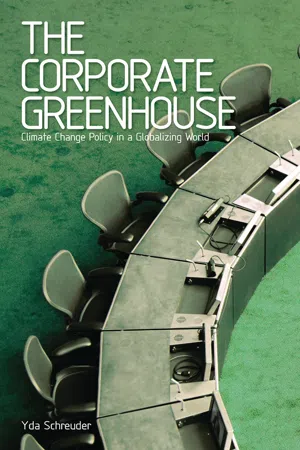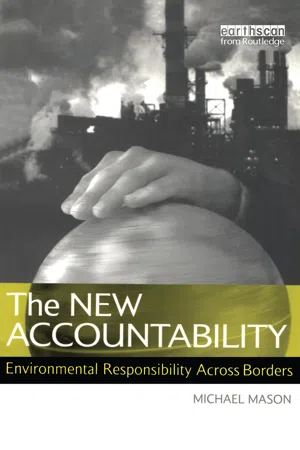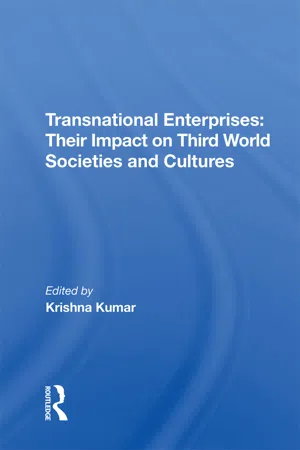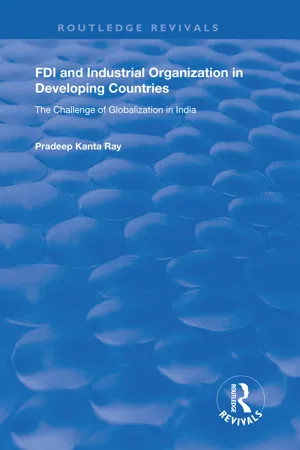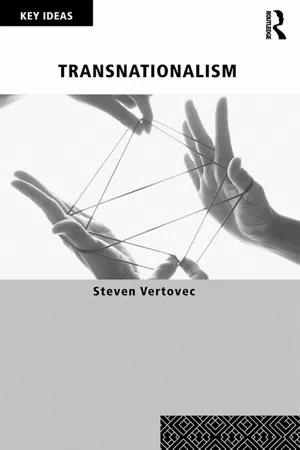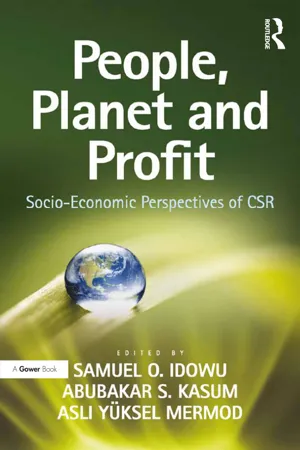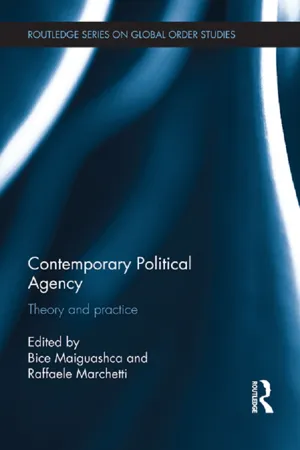Social Sciences
Transnational Corporations
Transnational corporations are large companies that operate in multiple countries, with headquarters in one country and subsidiaries in others. They play a significant role in the global economy, often exerting influence on local economies and politics. These corporations are known for their ability to move capital, goods, and services across borders, impacting various aspects of society and the environment.
Written by Perlego with AI-assistance
Related key terms
Related key terms
1 of 4
Related key terms
1 of 3
11 Key excerpts on "Transnational Corporations"
- eBook - ePub
The Corporate Greenhouse
Climate Change Policy in a Globalizing World
- Doctor Yda Schreuder(Author)
- 2013(Publication Date)
- Zed Books(Publisher)
4The transnational corporation and the global economyForeign trade and the transnational corporationThe rapid growth of multinational, or transnational, corporations is one of the most significant developments of the past few decades.1 Just as individual national economies are dominated by a small number of giant firms, so is the world economy dominated by large Transnational Corporations. This raises questions about the wisdom of considering solely national states or national governments responsible for emissions produced within their borders. To explain this, we will consider patterns of trade that have emerged with the activity of Transnational Corporations, which diverge considerably from the traditional international trade patterns established in a time when national governments held sway over economic affairs to a far greater degree than is the case today.Conventional trade theory assumes that producers and consumers are confined within their respective national borders. Thus, international trade results from production in one country and consumption in another. The activities of multinational corporations significantly complicate this conventional model. Since TNCs are, by definition, located in more than one country and operate their own economic subsystems of spatial interaction, each functional unit of a multinational or transnational corporation is both a global producer and a consumer. This distinction severely complicates the tracking of international trade flows and the attendant material and energy flows and carbon emissions associated with the finished products.2 The fact that these corporations are referred to as multinational or transnational indicates that they are viewed as enterprises that transcend and frequently compete with the interests of individual countries.3Trade within TNCs, or intra-firm trade, has been increasing along with the global scope of transnational corporate activities. Within the context of the global corporate economy, the domestic product of an American-based firm is tallied as domestic production, as is the gross product of the domestic subsidiary of a foreign-based TNC. Correspondingly, the imports and exports of these firms are calculated on the basis of cross-border movement of goods and services, regardless of the geographic location of ownership, strategic managerial control, or the ultimate flow of economic benefits. As a result, national accounting systems obscure the real impacts and benefits of global economic activity. Thus the idea of an American or Chinese national economy is becoming meaningless given the role of the TNC and of FDI, and national economic accounting practices are called into question. It follows that emissions allocations tabulated solely on the basis of national accounts would need to be adjusted. Given an equitable economic playing field, such accounting nuances would be of little concern; however, within a polarized global political economy, the tracking of such flows is a fundamental precursor to an equitable international environmental management scheme. - eBook - ePub
The New Accountability
Environmental Responsibility Across Borders
- Michael Mason(Author)
- 2012(Publication Date)
- Routledge(Publisher)
Chapter 6 The Environmental Accountability of Transnational Corporations DOI: 10.4324/9781849773140-7It is beyond dispute that Transnational Corporations (TNCs) are now the leading vehicles of economic globalization. Their cross-border financial flows of foreign direct investment (FDI) – comprising equity acquisitions, intra-company loans and reinvested earnings – are more important than global trade in realizing economic value. According to the United Nations Conference on Trade and Development (UNCTAD), in 2002 global sales of TNCs reached $18 trillion, compared with $8 trillion for world exports. While the start of the twenty-first century has seen the fourth major downturn in FDI since 1970 (down almost a third during 2001–02), in line with weak global economic growth, the stock of FDI is at unprecedented historical levels: the 2002 value of $7.1 trillion represented more than a tenfold increase since 1980. This stock – two-thirds of which is controlled by developed-world corporations (dominated by European, US and Japanese firms) – structures transnational production networks and investment chains affecting the livelihoods and living conditions of millions of people. In an immediate way, over 53 million people in 2002 were employed overseas by 64,000 TNCs through 870,000 foreign affiliates: the world's top 100 TNCs alone, with total assets approaching $6 trillion, employed 6.9 million foreign employees (UNCTAD, 2003 : ppxvi, 5). More widely, the social and ecological effects of TNC activity impact beyond the working lives of their employees, encompassing contractors, communities and ecosystems.The environmental consequences of TNC behaviour are multiple and substantial, if also contested. Clearly TNC investment decisions, production processes and resource transfers all impinge directly on social and ecological development paths. On one side is the familiar charge levelled by many environmentalists, and reinforced by ‘anti-globalization’ activists, that TNCs are ecologically irresponsible. The vivid image often employed here is of a ‘race to the bottom’, with global economic competition driving footloose corporations to seek locational advantages from investing in jurisdictions with minimal environmental regulation (e.g. Korten, 1995 : pp229–37; Retallack, 2001 ). As three-quarters of FDI flows into developing countries, a major concern is that ecologically damaging practices are concentrated in states least willing or able to mitigate their impacts on vulnerable populations, while the economic benefits generated by the domestic sectors receiving that FDI are, it is claimed, typically skewed towards local elites. Against this highly critical perspective is the view that TNCs have been voluntarily harmonizing ambitious environmental production and process standards across their different territories of operation. From the cost savings of more efficient material and energy usage, or the global market benefits of building a green reputation, ‘corporate environmentalism’ is seen to give at least some TNCs a competitive advantage (Porter and van der Linde, 1995 ; Mol, 2001 - eBook - ePub
- Henry Wai-Chung Yeung(Author)
- 2002(Publication Date)
- Routledge(Publisher)
geographical differences in the workings of network relationships, we look at the case of Chinese business firms and their transnational operations. Today, most Chinese business firms are still largely embedded in networks of business and personal relationships that will be examined in detail later in this book (see also Yeung, 1997a, 1997b). These business and personal networks of relationships are (1) socially specific because they are institutionalised in the Chinese business system and (2) geographically specific because they are primarily found among the overseas Chinese diaspora throughout the Asian region. The Chinese rely substantially upon personal and business relationships, as processes of business organisation, to engage in transnational operations. They tend to shy away from strategic alliances, but prefer to engage in informal and personal networks of inter-firm relationships. In this sense, the case of Chinese business firms contrasts nicely with typical Western firms in that the former rely upon networks as processes and relations whereas the latter rely upon networks as a form of organising economic activities. There are many social and cultural specificities in the different types of business networks and their transnational operations. In this book, I examine these specificities with reference to the case of TNCs from Hong Kong.Towards a broader definition of the transnational corporation
The above conceptualisation of the TNC both as network forms of structures and as processes and relations of network structures has serious implications for our definition of the TNC. What exactly is a transnational corporation, given the diverse range of activities in which it is engaged? To begin with, there are several alternative types of economic definition of the TNC (Buckley and Casson, 1985):1 an ‘operating’ definition: any firm that owns or controls income-generating assets in more than one country; 2 a ‘structural’ definition: multinationality is judged according to corporate organisation; 3 a ‘performance’ definition: some absolute or relative measure of international spread, e.g. number of foreign subsidiaries and percentage of sales accounted for by foreign sales; 4 a ‘behavioural’ definition: the corporation’s degree of geocentricity and spread.There are many problems associated with these different definitions of TNCs. First, as Cowling and Sugden (1987: 57) argue, there has been ‘a tendency to simply provide a definition [of the TNC] without deriving it from first principles’ such as the theory of the firm. The definition of TNCs by the United Nations Economic and Social Council is an example of an influential definition devoid of its theoretical roots. TNCs are referred to as ‘all enterprises which control assets – factories, mines, sales offices and the like – in two or more countries’ (UNCTC, 1978: 158). Second, for those definitions that are grounded in principles such as the theory of the firm, there is a problem of misguided focus. For example, following Coase’s (1937) view that the firm is the means of coordinating production without using market exchange, Buckley and Casson (1976) simply view the TNC as a firm in which the coordination of production without using market exchange takes the firm across national boundaries. This emphasis on the dichotomy between market and non-market exchanges (i.e. types of exchange) has fundamentally overlooked the nature of exchange, which, according to Cowling and Sugden (1987), should form the essential elements in the definition of TNCs. The mature Coase, in his 1988 lecture, recognised the central importance of organisational coordination among - eBook - ePub
Transnational Enterprises
Their Impact On Third World Societies And Cultures
- Krishna Kumar(Author)
- 2019(Publication Date)
- Routledge(Publisher)
Two limitations of the present, discussion can be mentioned here. In the first place, our focus is essentially on macro dimensions. Thus we do not examine the micro-level issues pertaining to what happens within the confines of a TNE in home or host nations, where people from different societies and cultures interact for rational, goal-oriented activity. In the second place, our emphasis is on developing nations. The term developing nations has undoubtedly lost some of its precise connotations and discriminating property in recent years for it has come to include nations such as Brazil, South Korea, and Taiwan which have sizable industrial sectors, as well as those countries which are yet to make any headway towards industrialization. However, despite its obvious limitation, we still find it of some heuristic value. We take it to be a residual category referring to those nations which cannot be classifed as industrialized and which have not opted for a socialist model of development. This overview is organized as follows: we begin with a working definition of transnational enterprises and briefly mention the recent trends and patterns in direct foreign investment. The second section examines the effects of TNEs on social structures and inequalities while the third section focuses on TNEs' impact on cultural systems. Finally, we explain the organization of this volume.Transnational Corporations: Recent Trend and Patterns
Since scholars have offered a wide variety of definitions of TNEs using different criteria-variables, it is necessary to mention that we follow the United Nation's definition which has the widest acceptance. Following this definition, TNEs are defined as the enterprises which "own or control production or service facilities outside the country in which they are based."1 These enterprises can operate in extractive, agricultural, manufacturing, or service sectors and can be private, semiprivate, or government-owned operations. Obviously, this definition excludes all those firms which do not own or control production and/or service facilities in foreign countries, and yet are involved in substantial foreign operations. The enterprises which operate within the confines of national boundaries have been termed as national enterprises (NEs).There are no reliable figures about the number of TNEs. However, a recent survey conducted by the European Economic Community noted that there were about 10,000 TNEs which were operating in more than one country.2 - eBook - ePub
- I. Wallace(Author)
- 2002(Publication Date)
- Routledge(Publisher)
7 Transnational Corporations in a world of sovereign states Power, leverage, and geopolitics When, in the 1960s, the global hegemony of the USA appeared to be still secure, its technology triumphant (e.g. in space), and its corporations conquerors of markets around the world, it became popular for the executives of US TNCs to write the obituary of the nation-state. Among many quotable comments recorded by Barnet & Muller (1974, pp. 18–21) are those lamenting the parochialism of nations, their obtuse and reactionary commitment to independence, and the obsolescence of the political divisions of the world which they perpetuate. In contrast, the commitment of the TNC to bringing about a ‘global optimization of resources’, and its functioning as an ‘instrument of world development…and the only force for peace’, was claimed to ensure that the rôle into which it was ‘being pushed by the imperatives of [its] own technology’ promised nothing less than prosperity and happiness for all. The earlier corporate ideology that ‘what is good for General Motors is good for the United States’ was being recast on a global scale. But as firms based in, and managed from, the USA became increasingly involved in the domestic economies of other states (both in the European core and the Third World periphery) as a result of their investments in foreign production facilities, governments of host countries were awakened to the need to come to grips with the impact of TNCs. The reality of potentially conflicting goals and of differential power to achieve them means that the relationships between sovereign states and powerful corporations play an important part in shaping the geography of the contemporary global economy. The modern TNC possesses, to a historically unprecedented degree, that structural freedom of action which accrues to economic enterprises in a capitalist world-economy characterized by fragmented political jurisdictions - eBook - ePub
FDI and Industrial Organization in Developing Countries
The Challenge of Globalization in India
- Pradeep Kanta Ray(Author)
- 2019(Publication Date)
- Routledge(Publisher)
Chapter 2The Role of Transnational Corporations in Economic Development 1
Introduction
If there is one phenomenon that has underpinned the massive upsurge of global interdependence today, it is the colossal explosion of the global operations of Transnational Corporations (TNCs). Estimates in 2001 by UNCTAD suggest that there are some 65 000 TNCs with about 850 000 affiliates across the globe accounting for 54 million employees; their sales of almost $19 trillion were more than twice as high as world exports in 2001 (UNCTAD 2002). Foreign affiliates alone control one-tenth of world GDP and one-third of world exports.2 The sales of top 200 TNCs accounted for a staggering 27.5 per cent of world GDP in 1999.3 Almost 85 per cent of the top 200 most powerful TNCs originate from the 6 most advanced nations in the world.This chapter searches the history of thought on FDI on two principal issues confronting developing economies today: the cost and benefit of foreign direct investment, and the appropriateness of the technological assets of the TNC. Consensus on this rather complex issue has been marred by many prejudices and biases despite the more mature and constructive analysis of FDI in recent years. Many developing countries seek FDI, and yet harbour a dubiousness about its effects. The precise underpinning of this distrust has eluded economic analysts. Here I am mainly concerned with the debate regarding welfare aspects of international capitalism in developing economies; the debate’s mainsprings are drawn from Stephen Hymer’s seminal thesis in 1960 towards his doctorate at MIT, ‘International Operations of National Firms’. Hymer’s analysis caused the flaring of a fierce controversy that centred around the relative merits of transnational affiliates and domestic enterprises as agents of development. The popular hypothesis was that, owing to their organisational ties to the parent, affiliates of TNCs behave differently from domestic firms, and hence their foreign presence exerts an independent (and often inimical) influence on development. In other words, international (dependence) capitalism is different from national capitalism. - eBook - ePub
- Steven Vertovec(Author)
- 2009(Publication Date)
- Routledge(Publisher)
2 TRANSNATIONAL SOCIAL FORMATIONS The studies of various social and political formations have embraced transnational perspectives. Can insights from the study of one kind of transnationalism have uses toward the social scientific understanding of another? The following chapter examines a number of research fields and topics in order (a) to review briefly a set of sociological concepts and to suggest that they have a kind of core bearing across the study of various transnational social formations, and (b) to outline some ideas and perspectives drawn from work concerning other kinds of transnationalism that might have some theoretical purchase if applied to the analysis of migrant forms of transnationalism. It is proposed that conceptual borrowing might prompt insights into global processes of social transformation as well as specifically shine further light on ways that contemporary migrants create, maintain and make use of modes of exchange and relationship that span considerable distances and nation-state borders. CROSS-FERTILIZING TRANSNATIONALISMS Global activities among individuals, groups and organizations today take a wide variety of forms. Although these activities share the adjective ‘transnational’, it is uncommon to find theoretical attempts to span them. In terms of transnational studies, Robert Keohane and Joseph Nye’s (1971) edited volume Transnational Relations and World Politics arguably represents a kind of landmark. The book’s contributors probed a set of transnational activities surrounding numerous kinds of border-crossing contacts, coalitions and interactions that are not controlled by organs of government. As a whole the volume raised important questions about a prevailing state-centric view of international relations. It emphasized the importance of ‘global interactions’ (defined as movements of information, money, objects and people across borders) and their impacts on interstate politics (see Nye and Keohane 1971) - eBook - ePub
- Christian Brütsch, Dirk Lehmkuhl(Authors)
- 2007(Publication Date)
- Routledge(Publisher)
fori, companies can pick up societal opinions and moods, anticipate risks and adjust their policies accordingly. Stakeholders gain a channel through which they can negotiate their positions and hold the company accountable.Conclusion: problems and unsolved questions of corporate social responsibility
Globalization has consequences for the process of legalization that can no longer be explained through the regulatory power of the nation state alone. On a global scale, rules developed on various levels and were mainly driven by private actors such as International Organizations, NGOs or Transnational Corporations (Günther and Randeria 2001; Teubner 1997). Many TNCs commit themselves to their own ‘codes of conduct’ that encompass basic standards in the areas of environmental, social, and labour rights. Through the implementation of these standards, TNCs became authentic sources for global rules (Scherer and Baumann 2004).The rather pragmatic reaction of TNCs to the dynamics of globalization took place long before the theoretical discourse was able to integrate these voluntary initiatives into its analytical framework. Now, as rule-setting activities of private actors are becoming more and more visible in the global arena, a rethinking of the traditional doctrine of sources of law has started and a discourse about the emerging legal pluralism on a global scale is underway.The argument that TNCs should participate in rule-making mechanisms on the global level provokes several questions and issues. We will concentrate on two major ones: (1) the question of how the problem of a growing democratic deficit of private actor’s rule making can be solved; (2) the problem of how the internal organization of TNCs must be changed so that structures and processes allow for engagement in public deliberation to contribute to the legalization of global rules. - eBook - ePub
People, Planet and Profit
Socio-Economic Perspectives of CSR
- Samuel O. Idowu, Abubakar S. Kasum(Authors)
- 2016(Publication Date)
- Routledge(Publisher)
Lenguyen, 2011 ). All these stakeholders are affected by corporate activities and may also have an effect on the corporations.More than any other business unit, Multinational Corporations (MNCs) are at the centre of CSR discourse. MNCs are spread all over the world and they control a significant percentage of the global economy. Their increased presence in the international political economy has led to the startling reality that companies can be political entities and their influence as political actors can be sizeable, both in positive and negative capacities (Holland, 2010 ). According to Pimpa (2011) , ‘it can be argued that the CSR movement would advance if different types of MNCs actively participated in various host country activities’ MNCs operate in both developed and underdeveloped countries, which are, of course, characterized by different competencies and needs. Developed countries are characterized by good regulatory and governance systems, and high levels of consumer protection law and customer awareness. On the other hand, ‘customers of developing countries are less educated and sometimes don’t know their rights or don’t care’ (Ndzibah and Maxwell, 2008 ). Their governments have limited capacity to provide good governance and regulatory systems and some governments have institutionalized ‘a less regulatory business environment’ (Iamandi, 2007 ).‘While increasing attention has been accorded in recent years to CSR, as a postulate for ethical and responsible behavior in business, very little is known of the practice of CSR in developing countries’ (Jamali and Mirshak, 2007 ). ‘Responsibilities assigned to corporations will not be pursued voluntarily’ (Kolstad, 2007 ) in their operations, plus the fact that regulatory framework and consumer education are known to be weak in developing countries. There is therefore a very high probability that CSR delivery may continue to be lopsided in favour of the developed countries. According to Werner (2009) , ‘there have been many examples in which corporations have taken advantage of developing countries’. Corporations’ operations have in addition been criticized for facilitating a situation in developing countries where ‘major shops are stocked with inferior products […] to suit the cheap market, which include electrical and electronic gadgets/appliances, wax prints, […] second[-hand] goods and discarded gadgets like computers, stereo sets, TVs, industrial machineries, receded tires, etc.’ (Ndzibah and Maxwell, 2008 ); while ‘it is evident that the best of technologies, the most innovative products and trends are meant for developed countries as well as the “cream” of every society’ (Ndzibah and Maxwell, 2008 - eBook - ePub
- Bice Maiguashca, Raffaele Marchetti(Authors)
- 2013(Publication Date)
- Routledge(Publisher)
Although this section did not make it into the final bill, its proposal was sufficient threat to cause NYSE-listed Talisman Energy, a Canadian oil firm, to pull out of Sudan. That same year, the SEC announced new disclosure rules which required US-listed firms to disclose activities in states subject to US government sanctions, such as Cuba and (at that time) Iraq.This blurring of boundaries, at the level of both the nation and the firm, has added new complexity to the classic question of the nature of a corporation. Is the modern multinational corporation, with its global reach in both production and sales, an organic entity, a social being with responsibilities, above and beyond simply obeying the law, to all of the various stakeholders – employees, customers, shareholders, creditors, suppliers, communities, even society as a whole – who are affected by its activities? And if, indeed, it is such an organic centre of power, in its global scope not unlike the British Empire of earlier days, how are the scope and limits of its social responsibilities to be defined and implemented? Or is this corporation simply a ‘nexus of contracts’, with residual responsibilities to only one group, its shareholders? From this latter perspective, the concept of ‘social responsibility’, global or otherwise, becomes meaningless as applied to a corporation. Such an entity has, as Baron Thurlow put it, ‘no soul to damn, no body to kick’ (Coffee 1981).3 Globalization and the changing environment for CSRCarl Kaysen (1957) listed stockholders, employees, customers, the general public and the firm itself as the constituencies owed a responsibility by the management of the corporation. Three major developments during the second half of the twentieth century changed relations among firms, managers and these various constituencies. The first was the progressive liberalization of cross-border trade in goods and services. Second, economic deregulation and/ or privatization in the domestic economies of many countries expanded the domain of the private sector and opened up new opportunities for market competition. Third, rapid advances in information and communications technology not only stretched supply chains in many industries virtually across the globe, as already described, but also created new industries and increased the tradability of many services long thought to be confined by their very nature to a single domestic market. - eBook - ePub
- Jan Lin, Christopher Mele, Jan Lin, Christopher Mele(Authors)
- 2012(Publication Date)
- Routledge(Publisher)
An important vein in the burgeoning literature examines the connectivities between what is, on the one hand, a rather abstract set of globalisation processes and, on the other, the processes of “transnationalism” which sustain “multi-stranded social relations” linking together “home” and “host” societies. It is argued that transnational practices and networks of capital, labour, business and commodity markets, political movements and cultural flows are both the products of, and catalyst for, contemporary globalisation processes. For example, transnational communities – communities that sit astride political borders and that, in a very real sense, are “neither here nor there”, but in both places simultaneously – are both created in response to, and at the same time sustain and fuel, the process of globalisation.An important site where the analytical lens can be trained to examine the way in which the material processes and discourses of globalisation and transnationalism intersect lies in dominant cities of the world urban hierarchy.[...]In this paper, we have chosen four groups of transnationals as our organising scheme, primarily because its range accords well with the framing of categories in local discourse in Singapore and at the same time allows us to put together side-by-side what are often treated as separate threads in global city debates.- “transnational business”, involving high-waged, highly skilled professional, managerial and entrepreneurial elites usually associated with finance, banking and business services;
- “third world populations”, comprising low-waged immigrants who occupy insecure niches in the unskilled or semi-skilled sectors of the urban service economy;
- “expressive specialists”, who participate in the cultural scene in areas such as art, fashion, design, photography, film-making, writing, music and cuisine; and
- “tourists”, who are present in considerable numbers, attracted by the cosmopolitan intensity of the global city.
For each category, we discuss the government’s notion of best practice in drawing in and negotiating with these transnational “outsiders” whose economic or social itineraries have converged, at least momentarily, in Singapore as a place. Each arena of debate has provoked new ways of thinking about the local, whether this be a questioning of the meaning of citizenship or a revalorisation of “local” or “traditional” heritage, or simply a concern for community benefits. Beyond examining the four different arenas of debate, we also give attention to the way discourses overlap, interconnect and reshape the parameters and contours of discussion. The paper points to the challenges to be addressed in Singapore’s bid to develop a “cosmopolitan and creative” global city epitomising the essence of transnationalism while at the same time remaining a “home” distinguished by a strong sense of local identity and community.
Index pages curate the most relevant extracts from our library of academic textbooks. They’ve been created using an in-house natural language model (NLM), each adding context and meaning to key research topics.
Explore more topic indexes
Explore more topic indexes
1 of 6
Explore more topic indexes
1 of 4
